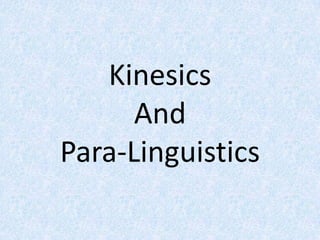
Kinesics and para linguistics
- 2. Kinesics • Kinesics – The study of body language – is the most important aspect of Non-verbal communication. • Body language is very suitable for expressing feelings and emotions. • Body language includes facial expressions, gestures, body movements, postures, eye contact and touch.
- 3. Facial Expressions • Face, they say, is the index of mind. Expert communicators are masters of this art. • Facial expressions can convey a wide range of responses like acceptance, rejection, satisfaction, dissatisfaction, anger, worry, surprise, shock, etc. • For example, A subordinate completes an assignment and takes it to his boss. The boss glances at the work and gives a smile. The smile expresses the boss’s satisfaction and approval. Wrinkles on face suggests worry.
- 5. Gestures • A gesture is the movement of the head, hands or legs to express an idea, feeling or emotion. • Speakers often use gestures to underscore their words. • Gestures may either accompany spoken words or stand alone. • Gestures can be both involuntary and conscious movements. • Theatre and cine artists are trained in using gestures effectively.
- 6. Body Movements • Body movements refer to the positioning or movement of the body when one is engaged in interpersonal communication. • They cannot be as subtle or meaningful as facial expressions or gestures. • They do express a few significant attitudinal postures. • eg. When people are involved and interested, they tend to lean towards the speaker, and they hold themselves back when they are not interested.
- 7. Postures • Posture means the way in which someone usually stand or sits or holds his shoulders, neck and back. • Postures can suggest whether one is relaxed or tensed up, enthused or feeling low. Sitting or standing with head erect suggests self-confidence, dignity and determination. • At interviews, the candidates postures entering the room, sitting in the chair and responding to the questions convey a lot of significant details about their personality.
- 8. Eye Contact • Eye contact is very subtle aspect of body language. It regulates interaction. • We like to maintain eye contact with the speaker if the topic of discussion is pleasant, but in unpleasant situations, we tend to look sideways or lower our eyes. • Influential and high-status people maintain high levels of eye contact. Eye contact indicates our willingness to interact while its absence suggests the desire to withdraw. • Good eye contact suggests self confidence, friendship, interest, affection. On the other hand absence of eye contact suggests inattentiveness, guilt, impatience.
- 9. Touch • Like gestures, touching is one of the earliest methods of communication among human beings. How a person touches someone sends important messages about their relationship and the situation in which they are placed. • It can reveal whether someone is caring, friendly, patronizing, indifferent or likely to intrude into others personal space. • Lovers, mothers and teachers use touch very effectively.
- 10. Para linguistics • The term paralanguage refers to a wide range of vocal characteristics like tone, pitch, speed of delivery, the use of pauses, word stress, etc. • Great orators know how to use these cues effectively.
- 11. Tone • Tone can be gentle, persuasive, appreciative, sarcastic, angry. • For example, take a very simple sentence: What an excellent piece of drafting. • If this sentence is spoken as an exclamation, it expresses admiration. However, if a touch of sarcasm is added to it, it will become highly condemnatory. • The actual meaning of this sentence can be understood from the speaker’s tone.
- 12. Pitch • Maintaining a constant pitch throughout one’s speech monotony. • Pitch variations are necessary to keep the listener attentive. • Generally speaking important parts of the message should be delivered at a pitch higher than the normal.
- 13. Speed of Delivery • Speaking fast is not synonymous with speaking fluently. If one speaks very fast words jam into one another and the effect is incomprehension. • As a rule, simple parts of the message can be delivered fast while important parts are spoken slowly with proper use of stress and pauses.
- 14. Pauses • Giving pauses at the right places is important for effective communication. • The normal practice is to give a pause before and after an important point. • The first pause creates suspense and raise anticipation. The second pause gives the listener sufficient time to assimilate the point made by the speaker.
- 15. Stress • Word stress is of two types: a. In words consisting of two or more syllables, some syllables are stressed to suggest change in meaning. Generally speaking, in two-syllabic words, in nouns and adjectives the first syllable is stressed while in verbs the second syllable is stressed. b. Important words in the message should be carefully stressed. Look at the following sentences and the difference in the meaning caused by the stress variation. I have checked the bills. (I myself) I have checked the bills. (only checked) I have checked the bills. (nothing except the bills.)
- 16. Speech Breakers • Utterances like ‘oh’, ‘err’, ‘you know’, also known as non- fluencies, either express the state of a person’s mind while speaking or the speaker’s inability to get the right words for a particular idea. • So they would either suggest confusion, distress, frustration, anger, etc, or they would be used as fillers. • Non-fluencies have a definite purpose. They allow the speaker a little breathing space in which he can find the right words and the listener an opportunity to assess the speaker’s state of mind better. • They should be used sparingly, for they interrupt the smooth flow of the message and show the speaker poor in light.
